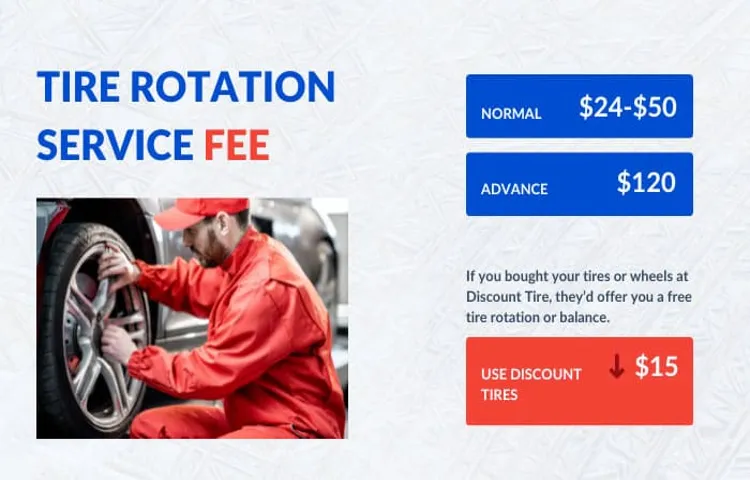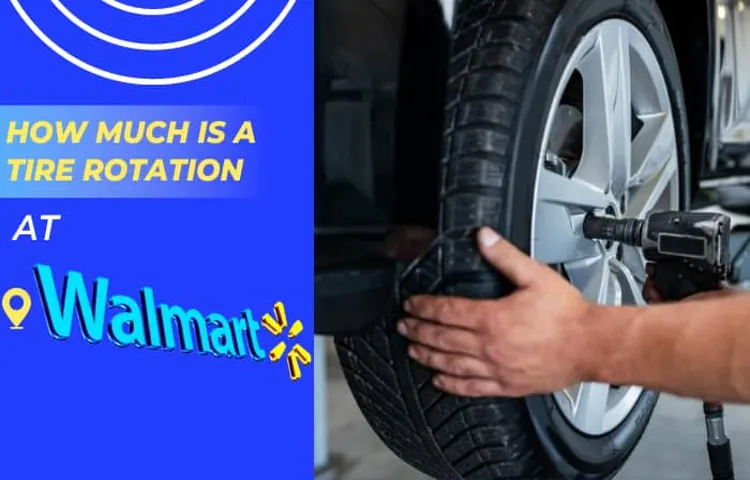Have you ever wondered about the cost of tire balancing and rotation? Well, you’re not alone. Whether you are a new car owner or looking to maintain your current vehicle, tire balancing and rotation is a crucial and often overlooked aspect of car maintenance. Not only does it increase the lifespan of your tires, but it also improves your car’s overall performance and safety.
However, as with any car maintenance, the cost of tire balancing and rotation can vary depending on various factors. In this blog post, we will dive into what tire balancing and rotation entails, the average cost, and what factors can influence this cost. So buckle up and let’s dive into the world of tire maintenance!
Table of Contents
Factors That Affect Tire Balance and Rotation Prices
“How Much for Tire Balance and Rotation?” The cost of tire balance and rotation services can vary depending on several factors. Firstly, the type and model of your vehicle can influence the price. Luxury and high-performance cars may require specialized equipment and expertise, resulting in higher costs.
Secondly, the type of tires you have can affect the price. Larger, heavier tires may cost more to balance and rotate than smaller, lighter ones. Additionally, the location and dealership you choose can impact the cost.
Prices may be higher in urban areas where the cost of living is higher, and luxury dealerships may charge more for these services than regular dealership. Lastly, the frequency of maintenance can also affect the price. Regular maintenance and tire rotations can prolong the lifespan of your tires and reduce the chance of more significant repairs in the future, ultimately saving you money in the long run.
Overall, the cost of tire balance and rotation services can vary for many different reasons, and it is always best to shop around and compare prices before picking a dealership.
Tire Size
Tire Balance and Rotation Prices When it comes to maintaining our vehicles, tire balance and rotation are essential factors to consider. However, many people are unaware of the different factors that affect these services’ pricing. One crucial factor is the tire size.
Larger tires typically cost more to balance and rotate due to their weight and size. The type of tire also plays a significant role in pricing. For example, high-performance tires that require specific handling and equipment can cost more than standard tires.
Another factor that influences the pricing is the location of the service. In urban areas, tire services are more expensive compared to those in rural areas. Additionally, the vehicle’s make and model can also affect pricing since different models have varying wheel sizes and shapes, affecting the balance and rotation procedure’s complexity.
Understanding these factors can help car owners budget accordingly and choose the right tire services for their vehicles.

Vehicle Type
When it comes to tire balance and rotation prices, there are several factors to consider, and one of the most important is the type of vehicle you have. Different types of vehicles have different requirements when it comes to tire balancing and rotation, and this can affect the price you pay for these services. For example, large vehicles like trucks and SUVs usually require more weight to balance their tires due to their size and weight.
This means that it will cost more to balance and rotate their tires compared to smaller vehicles like sedans and hatchbacks. Additionally, some vehicles have specialized tires that require extra care and attention during balancing and rotation, which can also increase the cost of these services. So, when you’re getting your tires serviced, make sure to take into account the type of vehicle you have to get an accurate estimate of the cost of balancing and rotation.
Brand of Tires
When it comes to getting your tires balanced and rotated, there are a few factors that can affect the price. One of the biggest factors is the brand of tires you have on your vehicle. Different tire brands have different specifications and requirements for balancing and rotating, which can impact the cost of the service.
Additionally, irregular wear or damage to the tires can also affect the price. For example, if your tires have uneven wear, your technician may need to perform more extensive balancing and rotation to ensure optimal performance and safety. It’s important to trust a professional technician for these services to ensure that your tires are properly balanced and rotated, regardless of the cost.
In the long run, regular maintenance of your tires can help you save money on costly repairs and replacements in the future. So, invest in your vehicle and prioritize tire care to keep you and your passengers safe on the road.
Average Cost of Tire Balance and Rotation
If you’re wondering how much it will cost to get your tires balanced and rotated, there are a few factors to consider. The average cost for this service ranges from $50 to $100, but it can vary depending on your location, the type of vehicle, and the type of tires you have. However, it’s important to note that getting your tires balanced and rotated regularly can help extend their lifespan and improve your vehicle’s overall performance.
Think of it like getting a regular check-up at the doctor’s office – a little bit of preventative maintenance can save you from costly repairs down the road. So, if you want to ensure your vehicle is running smoothly and safely, it’s worth investing in regular tire balance and rotation.
National Average Cost
The national average cost of tire balance and rotation varies from state to state and depends on several factors, including the type of car, type of tires, and where you go to get the service done. Generally, tire balance and rotation costs range from $20 to $100 per tire. Front tire rotation costs less than rear tire rotation, and the cost typically includes inspecting the tires for wear and damage.
The cost also depends on the type of tire balance needed, such as dynamic and static. Dynamic balancing is more expensive since it involves advanced technology to balance the tire. However, it is more precise than static balancing, which is cheaper but relies on the weight placed on the tire to balance it.
To save on tire balance and rotation costs, it’s essential to have your tires rotated and balanced on a regular basis, as recommended by the manufacturer or your mechanic. This helps ensure optimal tire performance and longevity, which can save you money in the long run.
Cost Comparison of Big Tire Retailers
If you’re in the market for new tires, it’s important to consider the cost of tire maintenance, such as balance and rotation, in addition to the initial purchase price. We researched the average cost of tire balance and rotation at several big tire retailers and found that there can be significant differences. On average, the cost of tire balance and rotation at national chain stores ranges from $20 to $30 per tire.
However, some retailers offer these services for free with the purchase of new tires. It’s important to do your research and compare the costs of both the tires themselves and the associated maintenance services before making a purchase. Don’t forget to also consider factors such as customer service, warranties, and installation fees.
By taking the time to do your homework, you can save money and ensure you get the best value for your investment in new tires.
Benefits of Regular Tire Balance and Rotation
If you’re wondering how much for tire balance and rotation, the cost varies depending on the service provider and your location. However, investing in regular tire balance and rotation can benefit you in the long run. Balanced tires can improve your vehicle’s fuel efficiency, reduce tread wear, and improve handling on the road.
On the other hand, regular rotation ensures that all your tires wear evenly, prolonging their lifespan. It also provides better traction and stability, especially when driving on wet or slippery roads. Not only does this increase your safety, but it also saves you money on premature tire replacements.
So, while the cost of tire balance and rotation may seem like an unnecessary expense, the benefits it provides in terms of safety, fuel efficiency, and tire longevity far outweigh the cost.
Extend Tire Life
Regular tire balance and rotation are essential for extending tire life and maximizing performance. The benefits of these maintenance practices are numerous. First and foremost, regular balancing helps to distribute the weight of your vehicle evenly across all four tires, which reduces wear and tear on individual tires and extends their lifespans.
Additionally, regular rotation allows for even wear on all tires, which not only extends their life but also improves handling and traction. By regularly maintaining tire balance and rotation, you can also improve fuel efficiency, as uneven tire wear can cause increased rolling resistance and decreased mileage. So, if you want to save money on tire replacements and improve performance and safety on the road, make sure to schedule regular tire balance and rotation appointments.
Your tires (and wallet) will thank you!
Improved Handling and Stability
Regular tire balance and rotation are crucial for achieving optimal handling and stability while driving. When tires are out of balance, it can cause vibration and uneven tire wear, leading to a decrease in handling and performance. Moreover, uneven wear puts a strain on the tire, leading to premature wear and tear, increasing the likelihood of a blowout.
With regular tire rotation, the tires wear evenly, ensuring a consistent level of performance throughout their lifespan. This not only ensures your vehicle’s safety but also leads to better fuel efficiency and cost savings in the long run. Therefore, it’s important to have your tires balanced and rotated every six months or with every oil change to ensure optimal handling and stability.
Remember, prevention is always better than cure when it comes to maintaining your tires’ health and performance.
Conclusion
In summary, the cost for tire balance and rotation varies depending on the location, the type of vehicle, and the service provider. But just remember, a well-balanced and rotated set of tires can save you from unexpected bumps and keep you cruising smoothly on your next road trip. So invest wisely, take care of your tires, and let the good times roll!”
FAQs
What is tire balancing and rotation?
Tire balancing and rotation is the process of evenly distributing the weight of the tires to ensure smooth driving and to increase the lifespan of the tires. During the process, each tire is removed from the vehicle, balanced, and rotated to a new position.
Why is it important to balance and rotate tires?
Balancing and rotating tires is important because it helps prevent uneven tire wear, improves handling, and extends the life of the tires. This can also improve fuel efficiency and save you money in the long run.
How often should tires be balanced and rotated?
Tire balancing and rotation should be done every 6,000 to 8,000 miles or every six months, whichever comes first. However, you should check your vehicle’s owner’s manual for the manufacturer’s recommendations.
What are the signs that indicate a need for tire balancing and rotation?
The signs that indicate a need for tire balancing and rotation include uneven tire wear, vibrations, pulling to one side, and noise or wobbling while driving. If you experience any of these symptoms, it is best to get your tires checked and serviced by a professional.
How long does tire balancing and rotation take?
Tire balancing and rotation typically takes about an hour to complete, but it may vary depending on the type of vehicle you have and the condition of your tires. It is recommended to get it done by a certified technician for best results.
How much does tire balancing and rotation cost?
The cost of tire balancing and rotation varies depending on the type of vehicle you have and the garage you choose. On average, it can cost between $50 to $100 for the service. However, you can expect to pay more for luxury or high-performance vehicles.
Can I do tire balancing and rotation myself?
While it is technically possible to do tire balancing and rotation yourself, it is not recommended unless you have experience and the proper tools. It is best to get it done by a certified technician for best results and to avoid any potential safety hazards.



